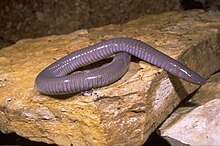Dermophis
| Dermophis | |
|---|---|

| |
| Tapalcua (Dermophis mexicanus) | |
| Scientific classification | |
| Domain: | Eukaryota |
| Kingdom: | Animalia |
| Phylum: | Chordata |
| Class: | Amphibia |
| Order: | Gymnophiona |
| Clade: | Apoda |
| Family: | Dermophiidae |
| Genus: | Dermophis Peters, 1880 |
| Species | |
|
7, see text | |
Dermophis is a genus of worm-like amphibians[1] in the family Dermophiidae, the Neotropical and Tropical African caecilians.[2][3] They are found in the Middle America between southern Mexico and northwestern Colombia. Common names Mexican caecilians or Neotropical caecilians are sometimes used for them.[2]
Species
The genus has seven species:[2][3]
| Binomial Name and Author | Common Name |
|---|---|
| Dermophis costaricense Taylor, 1955 | |
| Dermophis glandulosus Taylor, 1955 | |
| Dermophis gracilior Günther, 1902 | |
| Dermophis mexicanus (Duméril & Bibron, 1841) | Mexican caecilian, tapalcua |
| Dermophis oaxacae (Mertens, 1930) | Oaxacan caecilian |
| Dermophis occidentalis Taylor, 1955 | |
| Dermophis parviceps (Dunn, 1924) | La Loma caecilian, slender caecilian |
Description
The largest species, Dermophis mexicanus, can grow to a total length of 60 cm (24 in), while the smallest one, Dermophis parviceps, reaches only 60 cm (24 in). The body has numerous folds, from 97 to 258, with considerable variations both between individuals within a species and between the species. There is a tentacle about halfway between eye and nostril. The lower jaw has only one row of teeth.[4] Living specimens are very dark purple to purple-black above and creamy white below.[1]
Based on external morphology, three groups of species can be recognized:[4]
- large caecilians with numerous secondary folds: D. mexicanus and D. oaxacae
- moderate-sized caecilians with numerous secondary folds: D. costaricense, D. glandulosus, D. gracilior
- small to moderate-sized caecilians with few secondary folds: D. occidentalis, D. parviceps
References
- ^ a b Savage, Jay M. & Wake, Marvalee H. (1972). "Geographic variation and systematics of the Middle American caecilians, genera Dermophis and Gymnopis". Copeia. 1972 (4): 680. doi:10.2307/1442728. JSTOR 1442728.
- ^ a b c Frost, Darrel R. (2018). "Dermophis Peters, 1880". Amphibian Species of the World: an Online Reference. Version 6.0. American Museum of Natural History. Retrieved 21 December 2018.
- ^ a b "Dermophiidae". AmphibiaWeb: Information on amphibian biology and conservation. [web application]. Berkeley, California: AmphibiaWeb. 2018. Retrieved 21 December 2018.
- ^ a b Savage, Jay M. & Wake, Marvalee H. (2001). "Reevaluation of the status of taxa of Central American caecilians (Amphibia: Gymnophiona), with comments on their origin and evolution". Copeia. 2001 (1): 52–64. doi:10.1643/0045-8511(2001)001[0052:ROTSOT]2.0.CO;2.
